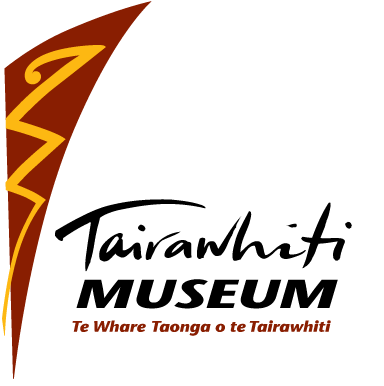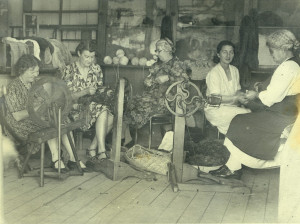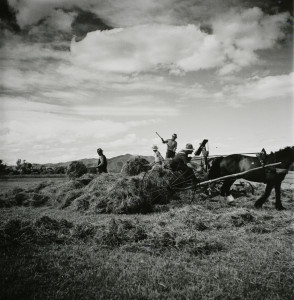Tairāwhiti WW2 Memories: The Home Guard and the E.P.S.
Tairāwhiti WW2 Memories: The Home Guard and the E.P.S.
In November 1940, First steps towards the enrolment of at least a battalion strength—totalling 480 men—for Home Guard service under the National Service Act, were taken in Gisborne. The elderly and partially fit men enrolling would be used mainly in guarding bridges and other communications, and dove-tailing with the Emergency Precautions Corps.[1] (The Emergency Precaution Scheme workers were council-appointed wardens who enforced blackout regulations and co-ordinated local rescues. They were in effect the fore-runners of Civil Defence. A corps was established in Gisborne following a visit from the associate Minister of National Service in August 1940.[2])
Four depots were arranged where Home Guard enrolment forms and information would be available, all males above the age of 16 being entitled to enrol. It was hoped to form four companies of 120.[3] I January 1941, the first parade of new Home Guard units in Gisborne was Held at the City Hall last, night, when the nucleus of four new companies was formed. However, more recruits were needed…… It was proposed to make the training as interesting as possible. There would have to be a certain amount of parade ground drill, but there would be no more than necessary to enable the units to move easily. At the moment there was a shortage of the necessary arms for training, and Colonel Gambrill made an appeal to any one in possession of rifles or revolvers to make them available.[4]
By March, the police had received 30 rifles for home guard use but more were needed. Although some of the country units were using a number of privately-owned weapons, the Gisborne Borough Battalion, in spite of an allocation from the Army ordnance stores, was still short of weapons and in order to conduct training they had had to ration these weapons among the combat units at the rate of one rifle to three men.[5] East Coast units were also short of rifles, and some men had to improvise with dummy rifles made from manuka or fence battens.[6] Several of the coast and country units also included mounted troops. (Acknowledgement of the potential usefulness of horses in the rugged back country areas was also made when the Gisborne mounted auxiliary of the Nursing Division of the St. John Ambulance Association was formed in 1940. They would act with the home defence forces if necessary, but the immediate objective, however, is to furnish the district with an auxiliary corps of women accustomed to riding and able to take care of themselves, and bring nursing assistance to patients in areas where medical and specialised nursing aid is not immediately available.[7])
In Gisborne, the Home Guard weeknight training was initially carried out at the Childers Road Reserve which had been made available by the Athletic and Harrier Club.[8] With the approach of winter, indoor training venues which were considered were : the Gisborne Sheepfarmers’ Frozen Meat and Mercantile Company’s wool store in Nesbitt road, Dalgety and Company’s store in Pitt street, and Williams and Kettle’s wool store in Awapuni road. With the use of the three wool stores and also the Intermediate, Central and other school buildings, it was considered that there would be sufficient space for winter training at night.[9] Other buildings utilised by the Home Guard were Allen Bros. and Johnstone’s Garage[10], Bignell and Holmes’ Garage,’[11] and Sargood’s Buildings, [12]
Training exercises were sometimes carried out in conjunction with the National Military Reserve[13]and the Independent Mounted Rifles, and the Emergency Precautions Services, such as this exercise held at Tolaga Bay :
Home-defence units and emergency precautions services based on Tolaga Bay yesterday undertook a large scale test of efficiency when a mock battle was staged between a troop of the Independent Mounted Rifles and a mounted troop of the Home Guard, the defending forces being supported by civilian sections handling communications, transport and casualties, Civilian residents of Tolaga Bay gave whole-hearted co-operation in the test, which involved the evacuation of people from the battle area, on the Hauiti side of the Uawa River. The tactical scheme was based on the possibility of a landing of enemy troops at the harbour works, and the necessity for fighting a delaying action with available home-defence units until reinforcements became available. This entailed the necessity of removing school-children and civilians in transport controlled by the emergency precautions services organisation,…..[14]
The attack on Pearl Harbour prompted the construction of defences against air raids, and by
the beginning of January 1942, over a mile of slit trenches have been dug close to the business area in Gisborne as protection against air raids, and all of the available areas have been used up in the. work, which has been designed to accommodate 1800 people. The council had undertaken to build trenches to serve only the business area, bounded in the west by Derby street and in the north and east by the river. Trenches for the residential areas must be dug by the residents themselves.. ….. The council would have liked to construct a greater length of trenches, Mr. Bull said, but there were no further areas available north of Childers road, and as the south side. of the road may be required for control by the military authorities, in the event of an emergency, the council agreed not to extend the trench construction beyond Childers road.[15]
In response to the threat of invasion there was another recruiting drive in January 1942,[16] and another appeal made for pea rifles, shot guns and revolvers.[17] In April it became compulsory for all men between 35 and 50 to enrol with the Home Guard. In all 730 enrolments were received from Gisborne and the East Coast.[18]The first appeals against service with the Home Guard were heard at the beginning of June. In this case the appeals were upheld as the men were already members of the Emergency Precautions Service.[19] However this was not always accepted as a sufficient justification, and there were debates between the two services at several appeal hearings, the arguments hinging on whether the person in question would render more valuable service in the E.P.S. or the Home Guard.[20]
A Home Guard parade at the beginning of June 1943 was planned to depict the changes which had taken place from January 1941, when the men paraded in civilian clothes and with arm bands as their only distinguishing mark, with only a few rifles available, through to the present, when all personnel were equipped in battle dress, and the rifle companies were equipped with modern rifles. The occasion also will mark the drafting of certain men up to 41 years of age into the Territorial Force.[21] At the end of the month, the Prime Minister announced that reductions were to be made in New Zealand’s mobilised army. From the 1st of July, members of the Home Guard would only be required to attend a full day parade of six hours once every three months.[22] The final parade of the Gisborne Battalion of the Home Guard was held in the City Hall on Wednesday 22nd March 1944.[23]
The Emergency Precautions Scheme was also wound down in mid 1943. [24] During the war the Council funded E.P.S. was responsible for civil defence operations, some of which paralleled services administered by the government. For instance, the Fire Patrol Unit came under the control of the E.P.S.[25] It was anticipated that the patrol would operate on the fringes of the business area and in the suburbs, and will be trained for immediate action to prevent minor outbreaks spreading to serious proportions. In addition, they would advise householders how to deal with small fires, and with incendiary bombs in the event of their being used by an enemy. [26] The Unit supplemented The Emergency Fire Service which was formed by the government. About 50 men served in the Gisborne E.F.S. [27]
Like their counterparts in the Home Guard, Gisborne E.P.S. units participated in practice drills – sometimes, it appears, somewhat hindered by the very people who would be depending on them in the event of an emergency:
With all the realism it was possible to impart in the peacefulness of Gisborne on a Saturday afternoon, the efficiency of the emergency precautions scheme was put to a test shortly after 1.45 o’clock to-day. An “enemy raiding party” landed close to the town, and, proceeding up the three main thoroughfares from the waterfront, they proceeded to shoot up the town and to throw bombs indiscriminately under the cover of an initial smokescreen. Unfortunately, something of the realism was lost by the congregation of a large crowd at the Peel street Gladstone road intersection and crowds of lesser proportions at other places. The “enemy” was the subject of some well-meant and good-natured badgering which all helped to make the turn-out appear something of a game rather than a try-out for the real thing. [28]
The Service faced a shortage of personnel in 1942 as men were drafted into the Home Guard.
Seventy High School boys were enrolled in the scheme,[29]but more help was needed. In July the committee of the Women’s War Service Auxiliary received an urgent appeal from the E.P.S. secretary for 150 assistant women wardens to replace the men.[30] By August, another 100 girls were required, and the officer in charge of the W.W.S.A. said that the response to the appeal had been very disappointing. Service with the armed forces was still attractive, and there was a steady flow of recruits for that type of work, but the girls remaining did not appear to realise that it was necessary for them to offer the spare time for work round their own homes. For wardens’ duties, 150 women and girls were required urgently, while a further 100 were needed as messengers with the communications unit, but the response had been almost nil in both respects.[31]
Part of the work of the E.P.S. involved co-ordinating with other service organisations which would be involved in emergencies, in particular the St. John Ambulance and the Red Cross. Preparations included trial invasions, such as the one in November 1941 which involved members of the auxiliary police, Red Cross, St. John Ambulance, transport, fire and all other sections connected with the E.P.S.
This was a major undertaking : Questionnaires delivered to all householders in the district recently have been collected, and the information has been recorded on master sheets so that headquarters will have a record of all householders and dependents, together with all surplus supplies of bedding and tents, in the various areas. A booklet containing advice to householders has been completed and will be delivered to householders before the end of the week, and it is hoped that they will make themselves conversant with the information contained in it.[32]
Members of E.P.S. and Home Guard participated in the muster of war-effort organisations which preceded the V-J Day thanksgiving service on 19th August 1945. On the route of the march, the order will be as follows: —The City Band; Mayor and members of the Gisborne Borough Council: returned servicemen and women of the present war; ex-members 4th I.M.R. Squadron; ex-members of 8th Independent Infantry Company and National Military Reserve; ex-members of Territorial units; Home Guard Band; ex-members of Home Guard units; ex-members of Line of Communications M.T. Company; service men and women of other campaigns; Air Training Corps; Red Cross transport section; Gisborne Pipe and Drum Band; Cook Hospital nurses; E.P.S. organisations; Chinese contingent: Salvation Army Band; Girl Guides; Boys’ Brigade, and Boy Scouts. [33]
– Christine Page, Museum Archivist
[1] The Gisborne Herald 1 November 1940
[2] The Gisborne Herald 24 August 1940
[3] The Gisborne Herald 16 November 1940
[4] The Gisborne Herald 23 January 1941
[5] The Gisborne Herald 10 March 1941
[6] The Gisborne Herald 12 February 1941, 18 February 1941
[7] The New Zealand Herald 12 September 1940
[8] The Gisborne Herald 29 January 1941
[9] The Gisborne Herald 15 May 1941
[10] The Gisborne Herald 31 May 1941
[11] The Gisborne Herald 9 May 1941
[12] The Gisborne Herald 24 June 1941
[13] The Gisborne Herald 31 May 1941
[14]The Gisborne Herald 2 June 1941
[15] The Gisborne Herald 9 January 1942
[16] The Gisborne Herald 2 January 1942
[17] The Gisborne Herald 14 January 1942
[18] The Gisborne Herald 16 May 1942
[19] The Gisborne Herald 13 June 1942
[20] The Gisborne Herald 19 June 1942
[21] The Gisborne Herald 29 May 1943
[22] The Gisborne Herald 28 June 1943
[23] The Gisborne Herald 24 March 1944
[24] The Gisborne Herald 12 July 1943
[25] The Gisborne Herald 12 July 1941
[26] The Gisborne Herald 12 July 1941
[27] The Gisborne Herald 26 June 1941
[28] The Gisborne Herald 22 September 1941
[29] The Gisborne Herald 16 April 1942
[30] The Gisborne Herald 30 July 1942
[31] The Gisborne Herald 6 August 1942
[32] The Gisborne Herald 26 November 1941
[33] The Gisborne Herald 18 August 1945



